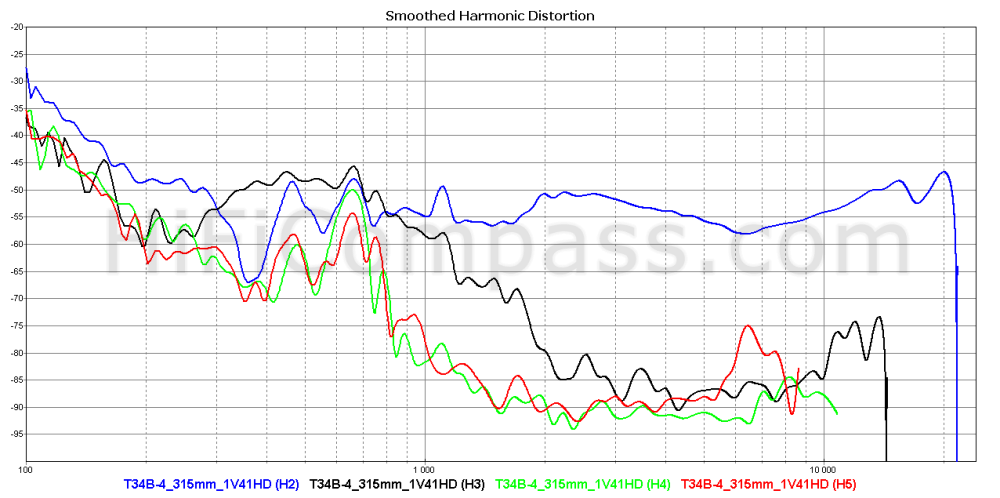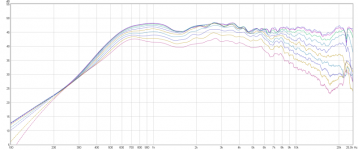Measure the new SEAS Titanium former tweeters, they cracked my all time record of -60dB distortion over 2kHz at 1Pa. They measure -65dB.
Measure the new SEAS Titanium former tweeters, they cracked my all time record of -60dB distortion over 2kHz at 1Pa. They measure -65dB.
So does that mean we should forget the diamond, beryllium hype and go with these?
Hope that helps.

It does not really help, it's rather confusing instead.
The graph you posted is the one measured at 1.41V input, so premumably at some 85dB SPL @ 1m. The gaphs I posted were the graphs at 5.6V input at presumably 97dB SPL@1m. So be careful in/by comparing apples to oranges.
at 1Pa.
Why don't you write "at 94dB (SPL)" like any one else does? Do you want to confuse people? Want to be special?
This is a good point.@Daihedz:
It's not puzzling at all. You are comparing a waveguided tweeter with regular one. Bliesma is smaller so CTC distance will be smaller also, unlike SS. Put Bliesma in a shallow waveguide and compare it then.
It's still puzzling for me. Going the other way round: Compare the Bliesma to the SS D2905/970000. The latter is exactly the same build, identical to the D2905/990000, except for it's waveguideless, plane faceplate. And this 97..-type has an incredible smooth frequency response, better than Bliesma below 20kHz, e.g. +- 1.5dB from 900Hz ... 20kHz. This comes at the price of some more THD above 10kHz and less sensivity because of no loading of the highest octave compared to the SS 99...-type.
Comparing all thoghether and allowing the waveguided 99..-SS, the Bliesma is better than the SS above 2.5kHz. Below 2.5kHz, the Bliesma is rather a regression.
As you suggest, it would be really interesting to investigate a waveguide-equipped Bliesma. But it will not be me spending money for this experiment, I would rather expect this kind of investigation from the part of Bliesma.
Most interesting ... Which tweeter exact type are you talking about, and where are some of it's measurement results published?Measure the new SEAS Titanium former tweeters, they cracked my all time record of -60dB distortion over 2kHz at 1Pa. They measure -65dB.
A bit vague in his descriptions and the only new SEAS tweeter that I am aware of is the 27TAC. If its not this one, he will correct it. circa $250 (give or take) a pairMost interesting ... Which tweeter exact type are you talking about, and where are some of it's measurement results published?
H1825-06 27TAC/GB
Interesting that the datasheet on that 27tac lists 830 Hz as Fs, but the impedance peak on the frequency reaponse graph is clearly a little over 900 Hz
The pair matching of Seas sucks lately increased prices for worse quality? Or maybe their priority are corporate customers and DIY gets leftovers anyway if it is these perhaps Joachim gets much better than Meniscus received for Wolf to test .A bit vague in his descriptions and the only new SEAS tweeter that I am aware of is the 27TAC. If its not this one, he will correct it. circa $250 (give or take) a pair
H1825-06 27TAC/GB
Why don't you write "at 94dB (SPL)" like any one else does? Do you want to confuse people?
Want to be special?
I don't know about that..
-but he doesn't have to "want" to be special: in this hobby/industry - he is special. 😉
The SEAS 27TAC has improved the off axis response, but the 25kHz breakup is nightmare fuel. Its among the worst I've seen for a "premium" tweeter, also the moving mass of 0.36 grams is also much higher than some of its competitors.
It supposedly is simply an improved 27TBFC. Copper cap where there was not one before, titanium (Titan line) voice coil former, a reshaped and carefully damped chamber, as well as being shipped/sold in matched pairs. I'll admit, the $91 price tag seems a bit high for production with a glass-reinforced plastic faceplate, but truth is you don't find titanium formers in very many drivers that cost less than $100. Normally they are aluminum, glass fiber, or Kapton. Seas uses a Corian material in their diamond line tweeters, so maybe they don't use metal faces often either. (I see Excel units are cast faces) The faceplate is really thick when it comes down to having plastic faces of any sort, along with what appears to be a metal hexagrid. The chamber cup and integrated divot remind me of those in the DX/XT line from Peerless, basically a sinusoidal curve of Pi length rotated around the Y axis. It's not quite a half-torus shape. Being that the TBFC is a bit splashy, and these have a copper cap to reduce HD, that is what tickled my fancy. More on the tweeter choice will come when I start posting info about the design path.
New Seas 27TAC/GB, some facts, some opinions, and some data... — MAC/DIY
Didn't the D2004/602000 have off-axis measurements posted before?
ScanSpeak D2004/602000 | HiFiCompass
ScanSpeak D2004/602000 | HiFiCompass
No, didn't🙁Didn't the D2004/602000 have off-axis measurements posted before?
ScanSpeak D2004/602000 | HiFiCompass
A review of the first PURIFI PTT6.5W04-01A midwoofer:
PURIFI PTT6.5W04-01A midwoofer review | HiFiCompass
PURIFI PTT6.5W04-01A midwoofer review | HiFiCompass
I looked at the surround and laughed thinking this would be crap.
Then I looked at the measurement and stopped laughing.
Then I looked at the measurement and stopped laughing.
On standby for the Bliesma T25 series subjective review 🙂 and I've got to read the article about the Purifi woofer
Yes, I remember[emoji6]On standby for the Bliesma T25 series subjective review 🙂 and I've got to read the article about the Purifi woofer
- Home
- Loudspeakers
- Multi-Way
- Some speaker driver measurements...

